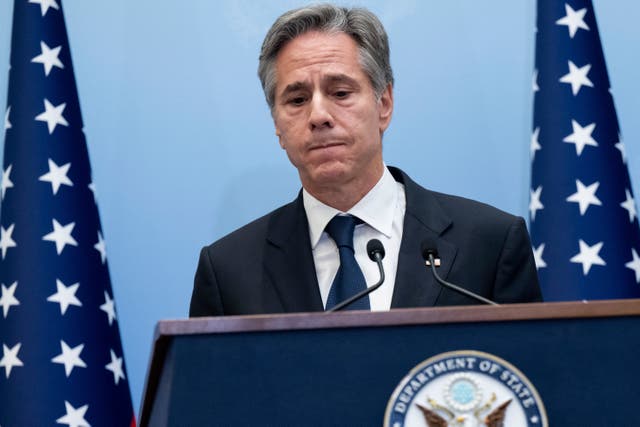Israel urges civilians to leave homes in Gaza as war with Hamas resumes

Israel’s war with Hamas has resumed in full force, with air strikes hitting targets in the Gaza Strip minutes after a week-long truce expired.
Black smoke billowed from the besieged territory and Israel dropped leaflets over Gaza City and southern parts of the enclave, urging civilians to leave their homes to avoid the fighting.
In Israel, sirens warned of incoming rockets at several communal farms near Gaza, a sign that militants have also restarted attacks.
The renewed hostilities heightened concerns for Palestinians — many of whom have been displaced by the war — as well as about 140 hostages still in Gaza, after more than 100 were freed during the truce.
Qatar, which has served as a mediator along with Egypt, said negotiators were still trying to restart the ceasefire. Qatar’s Foreign Ministry singled out Israel’s role in the resumption of fighting and said it “complicates mediation efforts and exacerbates the humanitarian catastrophe”.
A day earlier, US Secretary of State Antony Blinken met Israeli officials and urged them to do more to protect Palestinian civilians as they seek to destroy Hamas.
Mr Blinken arrived on Friday at the Cop28 climate talks in Dubai, where he was to meet Arab foreign ministers and other officials.
Israel’s retaliation for Hamas’s deadly October 7 raid has killed thousands of Palestinians, uprooted most of Gaza’s 2.3 million people and led to a humanitarian crisis.
Hundreds of thousands of displaced people are crammed into the territory’s south with no exit, raising questions over how any Israeli offensive there could avoid heavy civilian casualties.
It was not clear to what extent Israeli Prime Minister Benjamin Netanyahu will heed appeals from the United States, Israel’s most important ally.
Mr Netanyahu’s office said on Friday that Israel “is committed to achieving the goals of the war: releasing the hostages, eliminating Hamas and ensuring that Gaza never again constitutes a threat to the residents of Israel”.
Only hours in to the renewed offensive, the Health Ministry of Hamas-controlled Gaza said 109 people had been killed and dozens wounded.

In the leaflets it dropped in southern Gaza, Israel urged people to leave homes east of Khan Younis, warning that the southern town was now a “dangerous battle zone”. Other leaflets warned residents of several neighbourhoods in Gaza City in the north to move south.
The Israeli military also released a map carving up the Gaza Strip into hundreds of numbered parcels, and asked residents to learn the number associated with their location in case of an eventual evacuation. It was not immediately clear how Palestinians would be updated on calls for evacuation.
Hundreds of thousands of people fled northern Gaza earlier in the war in an extraordinary mass exodus that saw many take shelter in Khan Younis and other places in the south.
One of the first air strikes on Friday destroyed a large building in Khan Younis. Moments later, residents were seen frantically searching the rubble for survivors as medics approached. One wounded person was carried away on a stretcher.
In Hamad City, a Qatari-funded housing development near the city, a strike hit an apartment in a multi-storey residential building, while other parts of the building appeared largely intact.
Elsewhere, a strike hit a home near Gaza City in the north, and in the refugee camp of Maghazi, in central Gaza, rescuers clawed through the rubble of a large building hit by warplanes.
Israel has said it is targeting Hamas operatives and blames civilian casualties on the group, accusing the militants of operating in residential neighbourhoods. Since the war erupted on October 7, in response to a deadly Hamas attack on southern Israel, many of those killed in Israeli bombardments have been women and children.
In Israel, white smoke trails could be seen in the skies over Sderot on the border with northern Gaza after Israel’s missile protection systems activated.
Mr Netanyahu said the war resumed because Hamas had violated the terms of the truce. “It has not met its obligation to release all of the women hostages today and has launched rockets at Israeli citizens,” he said.
Hamas claimed Israel had asked for the release of 10 female soldiers, which it rejected.
Hamas blamed Israel for the end of the truce, saying in a statement that it had rejected all offers Hamas made to release more hostages and bodies of the dead.
The Israeli military’s announcement of the resumption of strikes came only 30 minutes after the ceasefire expired early Friday.
During the week-long truce, Hamas and other militants in Gaza released more than 100 hostages, most of them Israelis, in return for 240 Palestinians freed from prisons in Israel.

Virtually all of those freed were women and children but the fact that few such hostages now remain in Gaza made it hard to reach a deal to extend the ceasefire.
Hamas, a militant group that has ruled Gaza for 16 years, had been expected to set a higher price for the remaining hostages, especially Israeli soldiers.
Mr Netanyahu has been under intense pressure from families of the hostages to bring them home but his far-right governing partners have also pushed him to continue the war until Hamas is destroyed, and could abandon his coalition if he is seen as making too many concessions.
A total of 81 Israelis, including dual nationals, were freed during the truce, most of whom appeared physically well but shaken. Another 24 hostages — 23 Thais and one Filipino — were also released, including several men.
The Palestinian prisoners who were released were mostly teenagers accused of throwing stones and firebombs during confrontations with Israeli forces. Several were women who were convicted by military courts of attempting to attack soldiers.














